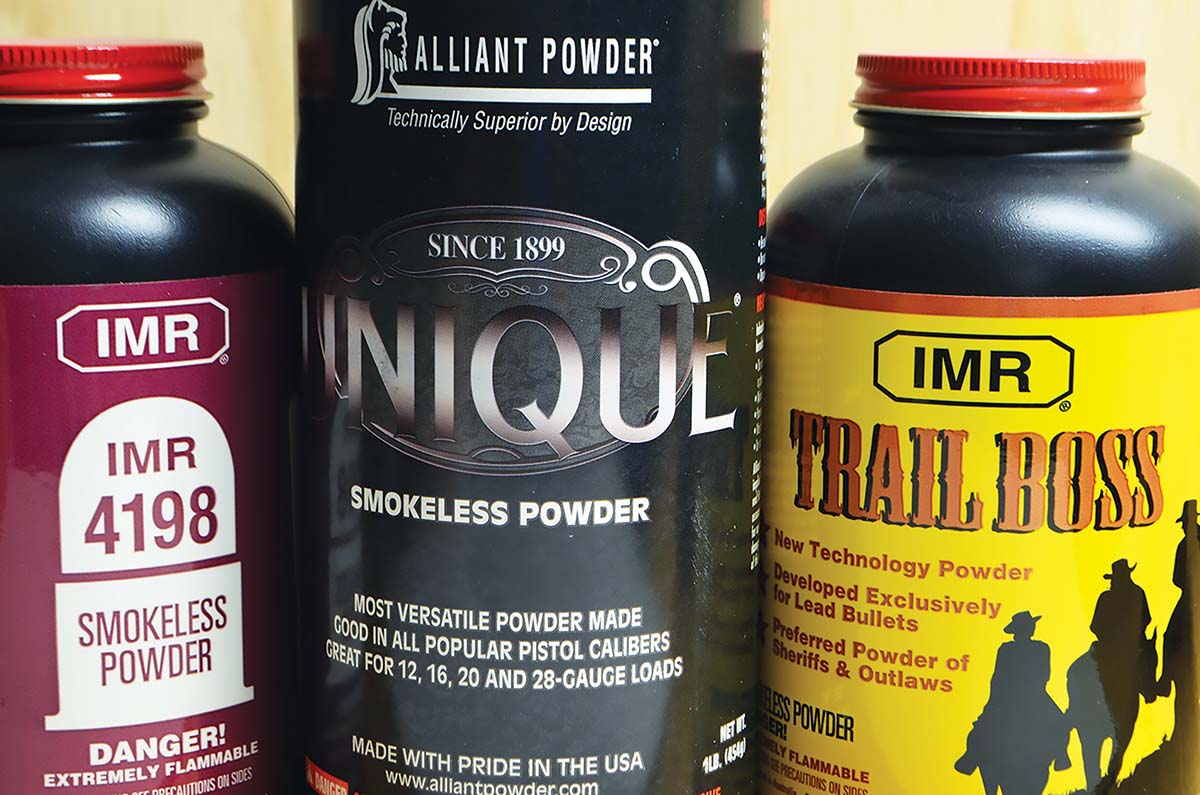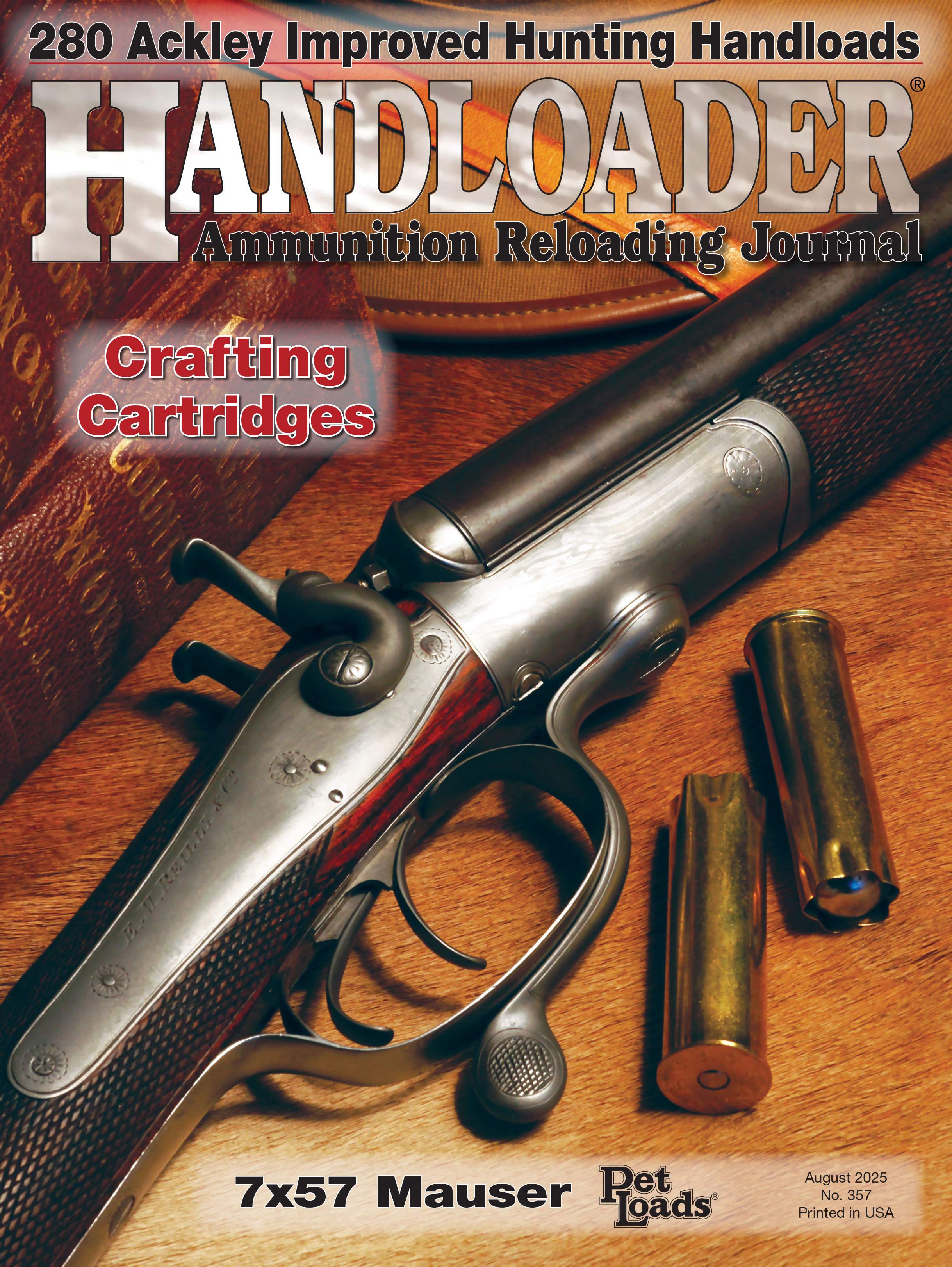In Range
column By: Terry Wieland | July, 25

Actually, none of these possibilities is strictly true, although each has elements of truth, and more than once I’ve tried to figure out powder relationships and asked myself, “What were they thinking?”
For example, the original IMR-4350 came along in 1940, the slowest burning in the line of Improved Military Rifle (IMR) powders from DuPont. During the war, DuPont made what came to be known as 4831 for the U.S. government to load in 20mm Oerlikon cannon rounds, and after 1945, large lots of it were sold off as surplus, notably to Bruce Hodgdon, founder of the Hodgdon Powder Company.
So far, so good. Lacking a name or number for his surplus powder, but knowing it to be slower that 4350, Hodgdon designated it “4350-Data” powder, since any load with 4350 would be safe. This is a conclusion that could be debated in today’s super-safety-conscious society, but remember, this was 70 years ago. By the way, at that time, there was only one powder called 4350, so nothing more specific was needed.
As belted magnums became all the rage, Hodgdon’s 4831 became powder of the month, and in 1973, DuPont introduced its own IMR-4831 as a canister powder available to handloaders. From that point on, Hodgdon’s original had to be designated “H-4831” to differentiate it. Of course, no one went back and changed all the load data in manuals and magazines, so if you see just “4831” in an old manual, it’s the Hodgdon variety.
When the supply of surplus 4831 ran out, Hodgdon approached a Scottish company to produce a new stock, along with some additional numbers. Among these was an equivalent to 4350, which became H-4350 in 1982. It was the same situation as 4831, but in reverse. Any pre-1982 reference to 4350 is the IMR product.
This would be merely a mildly intriguing semantic exercise if powders with the same numbers were interchangeable, but they are not. You cannot substitute IMR-4831 for H-4831 willy-nilly. The differences are not huge, and in light loads, they are probably not life-threatening, but they are there. The same is true of the 4350s: Close, but no cigar.
Just to add to the confusion, the Accurate Arms Company line later included AAC-4350. When the aforementioned Scottish powder manufacturer decided to tackle the U.S. market independently, one of its four original offerings was Brigadier 4351, which was, perhaps inadvertently, referred to in an early review as Brigadier 4350.
Anyone new to the game, confronted with this dog’s breakfast of powder nomenclature, might throw their hands in the air and stick with factory ammunition. It takes a serious interest, not only in handloading but in the history of its participants, to sort all this out. At the very least, it requires close and careful reading of labels and load data.
There are other examples: IMR and Hodgdon have a 4198, a 4895, and formerly, a 4227. Fortunately, there is a wealth of data for all in newish publications; as long as you read labels and stick to published data, there should (!) be no problem.
Some other powder anomalies are stranger.
For example, there are powders that are virtually identical (some have written exactly identical), but with different names, from different companies. Norma’s original MRP of hallowed memory and Alliant’s Reloder 22 are two such. They appeared in the same era, MRP in 1975, Reloder 22 in 1988, and were produced in the same Nobel powder mill.
Identical? Methinks not – at least, not based on my experience. MRP came and went over that period as Norma tested, abandoned, and re-tested the American market. When it disappeared in the 1990s, I attempted to work up a load for my 257 Weatherby to match a gilt-edged one with MRP, and never succeeded; the velocity was there, but not the accuracy.
There are also powders that have th same name but are not identical. Again, Norma’s MRP, the reintroduced MRP from a few years later, and later still, MRP 2.
Some of the confusion can be attributed to the never-ending game of musical chairs played by powder manufacturers, beginning in the modern era with the break-up of the DuPont de Nemours monopoly in 1912. After the split, we had Hercules, which produced double-base powders (nitroglycerine and nitrocellulose) and DuPont, which were single-base powders.
Since then, Hercules has changed partners on the dance floor several times, and while the powders have largely remained the same, the company name has changed from Hercules to Alliant.
So, we have examples of the companies remaining the same but the powder changing, and the powder remaining the same while the companies changed.
The oldest powder available, and also one of the most useful, is Bullseye. There is only one, it comes from Hercules-Alliant, and it’s been around since 1898. Bullseye is the fastest burning and is used in tiny amounts in handgun cartridges.
How tiny? Years ago, I had a friend, a serious handgunner and reloader, who, early in his marriage, sneaked some money out of the house and bought a 20-pound keg of Bullseye. I only met him years after he’d retired as a history teacher, and he showed me the keg. It was still not empty and, as far as I know, was not at the time of his death. A little math illustrates the situation: 20 pounds is 140,000 grains; at four grains per load – a middle-of-the-road charge for a 38 Special – that would give him 35,000 rounds.
The second-oldest is also an original Hercules product, Unique, dating from 1899. Generally speaking, Unique is more useful than Bullseye in that it has applications for rifle, handgun and even shotgun cartridges.
Unique is on my short list of powders never to be without, so the fact that it’s listed as “out of stock” everywhere I’ve looked is more than a little alarming. I’m somewhat soothed by the knowledge that I have three or four pounds in reserve, and given the usual amounts used (five to 15 grains, depending), that should last a good long time.
This brings up another point: While new powders come on the market at a dizzying rate, all of them seem highly specialized, intended for one class of cartridge or one specific application.
Unique is, uh, uniquely versatile, but none of the new ones are. SR-4759 was one of the original DuPont “sporting rifle” powders, which had applications in several areas. It was discontinued, then brought back, then finally abandoned for good a dozen years ago.
IMR, by then part of Hodgdon, introduced Trail Boss and suggested it as a replacement for SR-4759, in terms of general application if not performance. My old friend, Bob Hayley (Hayley’s Custom Ammunition), used a lot of SR-4759 and had wisely laid in a goodly supply when it was reintroduced. (Much of it was still in his shop when he died in 2020, and was disposed of in some ignominious way by the executors who feared it might explode. Sheesh.)
Anyway, Bob tried Trail Boss (now rebranded as Hodgdon) in some of his creations for old handguns and rifles and could not get nearly the performance of SR-4759. It made the guns go bang, but that was where it ended.
I wrote about Unique and Bullseye and their unavailability (along with other Alliant products) three issues back, and as I write this in April 2025, everywhere I look all are still listed as out of stock. Northrop Grumman owns the old Hercules (Alliant) powder mills. Given the rush to rearm in the West, and Northrop Grumman’s likely role in that, I for one am not expecting Unique to reappear any time soon.


